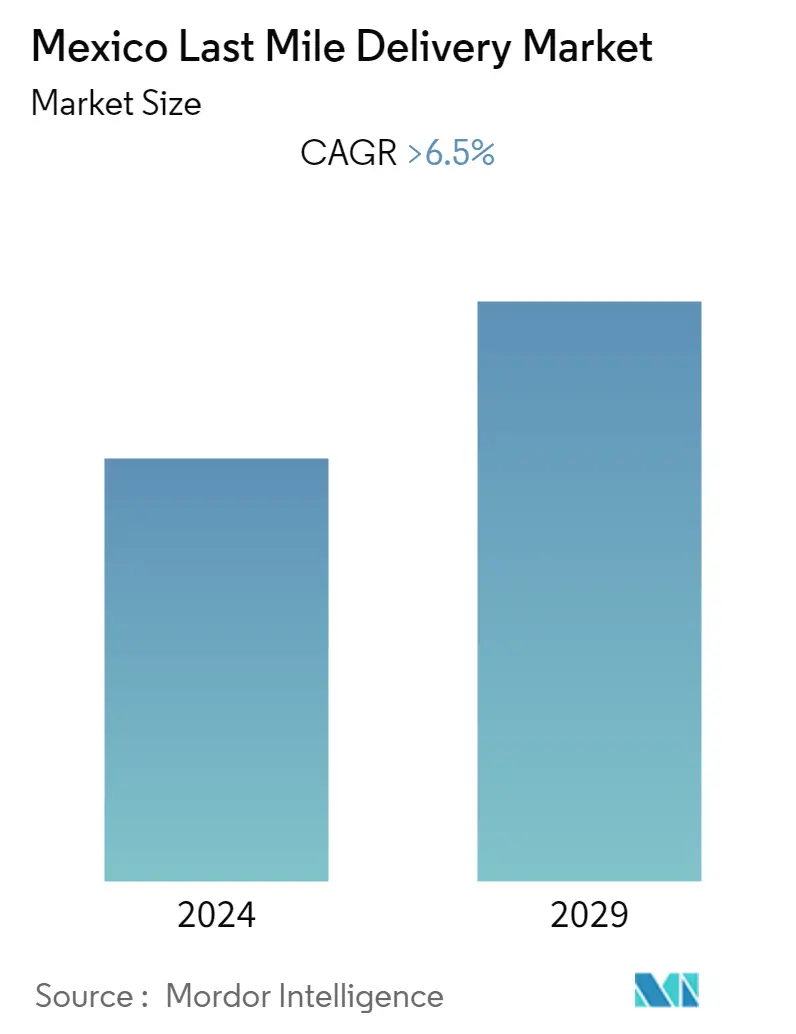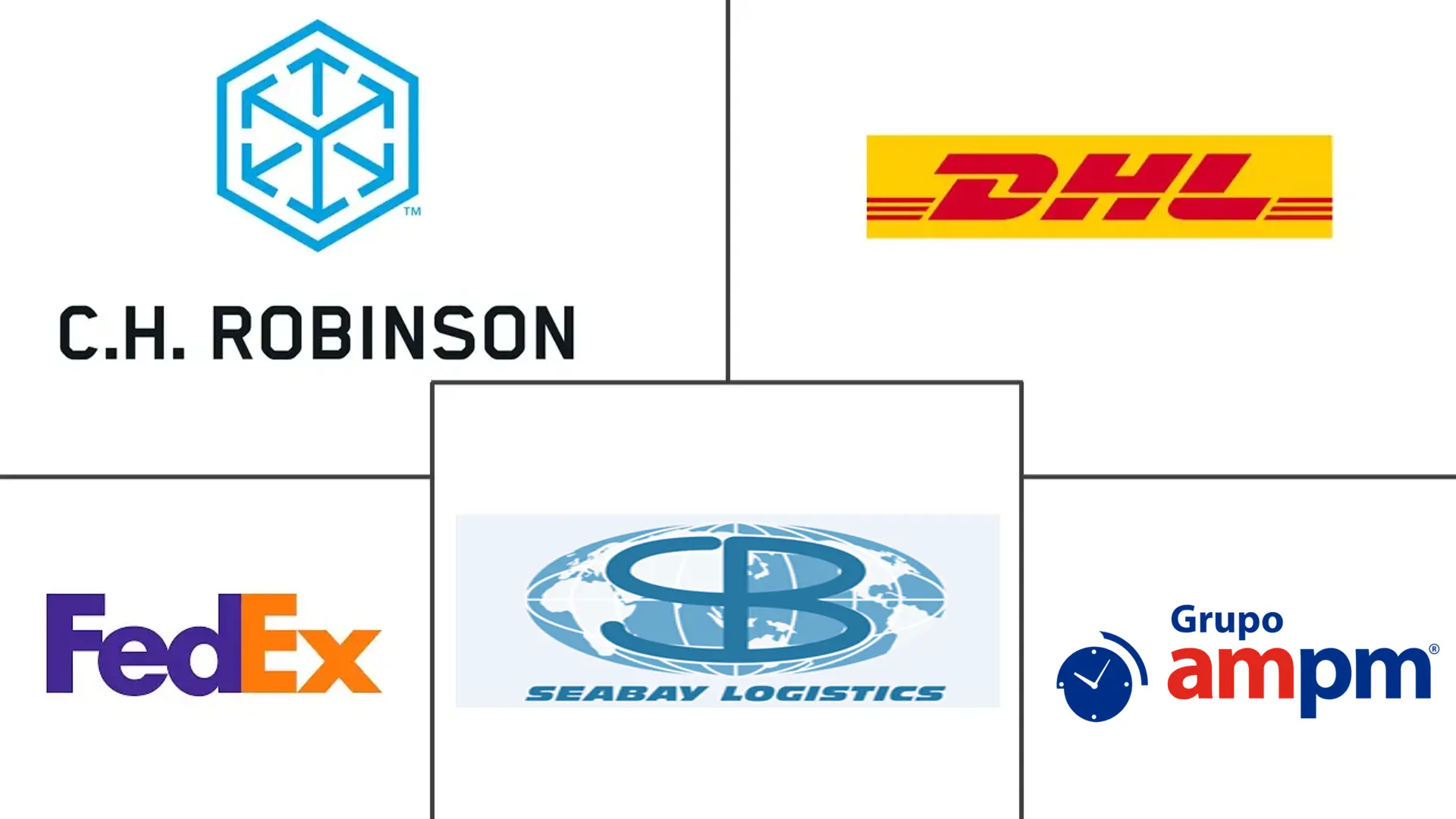Market Size of Mexico Last Mile Delivery Industry

| Study Period | 2024 - 2029 |
| Base Year For Estimation | 2023 |
| Forecast Data Period | 2024 - 2029 |
| Historical Data Period | |
| CAGR | 6.50 % |
| Market Concentration | Low |
Major Players
*Disclaimer: Major Players sorted in no particular order |
Mexico Last Mile Delivery Market Analysis
The Mexican Last mile Delivery Market is valued at about 15.5 USD Billion and is expected to grow at a CAGR of more than 6.5% during the forecast period.
- Like in other marketplaces around the world, the COVID-19 pandemic altered consumer behaviour in Mexico. Consumers were prompted to test and adopt digital channels by limited access and mobility constraints during 2021 and into 2022, which also served to emphasise the significance of grocery retail as the principal supplier of essential food, drinks, and supplies for personal and home care for households across the nation. Mexican grocery stores are vying to develop robust e-commerce capabilities and solutions. The predicted gross merchandise value of modern trade in 2021 (hypermarkets, supermarkets, and convenience stores) was more than USD 20 billion, with an increasing portion going to Internet sales. Customers' expectations of delivery timeframes for essential groceries and convenience goods are changing as pure-play digital grocery startups have emerged, incumbents are stepping up their attempts to become genuine omnichannel players, and last-mile solutions are reshaping those expectations.
- Even established businesses like mom-and-pop shops are undergoing change. The distinction between who does what in the sector is becoming more hazy as these smaller, unorganised retail players use their essential consumer product-supplier capabilities to develop or implement e-commerce solutions. Retail players who are digital natives and have previously upended other marketplaces around the world can now enter the industry thanks to this change. Even established businesses like mom-and-pop shops are undergoing change. The distinction between who does what in the sector is becoming more hazy as these smaller, unorganised retail players use their essential consumer product-supplier capabilities to develop or implement e-commerce solutions. Retail players who are digital natives and have previously upended other marketplaces around the world can now enter the industry thanks to this change.
- Although large parcel companies cover specific solutions, in recent years several startups focused on last-mile logistics have emerged in Mexico. In Mexico, deliveries are generally not fulfilled within 24 hours. A few of the challenges that these logistics companies face include the cost of transporting the product, which accounts for 53% of the total cost of the supply chain. Additionally, customers are apprehensive to purchase online in part due to the high cost of fast delivery. Another challenge is the cost of fuel, which accounts for 5% of operating expenses. Moreover, it is a dollarized cost that lies outside the control of the retailer or the logistics company.
Mexico Last Mile Delivery Industry Segmentation
Last mile is a term utilized in supply chain management and transportation wanting to depict the last leg of a journey including the movement of people and goods from a transportation center to a final destination. A complete background analysis of the Mexican Last-Mile Delivery market, which includes an assessment of the economy, market overview, market size estimation for key segments, emerging trends in the market, market dynamics, and key company profiles are covered in the report. The report offers market size and forecasts in values (USD billion) for all the above segments.
| By Service | |
| Same-Day Delivery | |
| Regular Delivery | |
| Other Express Delivery |
| By Business | |
| B2B (Business-to-Business) | |
| B2C (Business-to-Consumer) | |
| C2C (Customer-to-Customer) |
| By End User | |
| Consumer & Retail | |
| Food & Beverages | |
| Pharmaceuticals & Healthcare | |
| Others |
Mexico Last Mile Delivery Market Size Summary
The Mexican last mile delivery market is experiencing significant transformation, driven by the shift in consumer behavior due to the COVID-19 pandemic. As consumers increasingly turned to digital channels for their shopping needs, the importance of efficient last mile delivery solutions became paramount. This shift has prompted traditional grocery retailers to enhance their e-commerce capabilities, while new digital-native players have entered the market, further intensifying competition. The market is characterized by a blend of established companies and emerging startups, all vying to meet the evolving expectations of consumers who demand faster and more reliable delivery services. Despite challenges such as high transportation costs and fuel prices, the market is poised for growth as more consumers in Mexico embrace online shopping, a trend that is expected to continue in the coming years.
The expansion of e-commerce in Mexico is a key driver of growth in the last mile delivery sector. As online shopping becomes more prevalent, the demand for efficient delivery solutions is increasing, with e-commerce transactions expected to account for a larger share of retail sales. The market is also witnessing the rise of cross-border e-commerce, with Mexican consumers increasingly purchasing from international websites. This growth is supported by the presence of both international and national logistics players, as well as new startups that are innovating to bridge the gap between e-commerce brands and consumers. The market's fragmentation presents opportunities for companies to differentiate themselves through specialized services, such as those offered by DHL and C. H. Robinson. As the market continues to evolve, the focus on reverse logistics and the integration of technology in delivery processes are expected to drive further growth and efficiency.
Mexico Last Mile Delivery Market Market Size - Table of Contents
-
1. MARKET INSIGHTS
-
1.1 Current Market Scenario
-
1.2 Technological Trends and Automation in Last Mile Delivery
-
1.3 Insights into E-commerce industry in Mexico
-
1.4 Government Regulations and Initiatives
-
1.5 Insights on Warehousing and Distribution Centers
-
1.6 Value Chain / Supply Chain Analysis
-
1.7 Insights on Refrigerated Last Mile Delivery
-
1.8 Insights on Return Logistics
-
1.9 Insights on Deliveries during Festive season
-
1.10 Insights into Cross-Border Trade of Mexico with Other Countries
-
1.11 Impact of COVID-19 on Mexican Last Mile Delivery Market
-
-
2. MARKET SEGMENTATION
-
2.1 By Service
-
2.1.1 Same-Day Delivery
-
2.1.2 Regular Delivery
-
2.1.3 Other Express Delivery
-
-
2.2 By Business
-
2.2.1 B2B (Business-to-Business)
-
2.2.2 B2C (Business-to-Consumer)
-
2.2.3 C2C (Customer-to-Customer)
-
-
2.3 By End User
-
2.3.1 Consumer & Retail
-
2.3.2 Food & Beverages
-
2.3.3 Pharmaceuticals & Healthcare
-
2.3.4 Others
-
-
Mexico Last Mile Delivery Market Market Size FAQs
What is the current Mexico Last Mile Delivery Market size?
The Mexico Last Mile Delivery Market is projected to register a CAGR of greater than 6.5% during the forecast period (2024-2029)
Who are the key players in Mexico Last Mile Delivery Market ?
C. H. Robinson, APL Logistics, Grupo ampm, DHL and FedEx are the major companies operating in the Mexico Last Mile Delivery Market .

